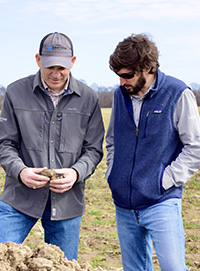 A healthy foundation for generations of harvests is built from the ground up — literally. Understanding the complexity of the soil supporting your crop’s growth is key to a successful future for your farm.
A healthy foundation for generations of harvests is built from the ground up — literally. Understanding the complexity of the soil supporting your crop’s growth is key to a successful future for your farm.
Healthy soils share common characteristics including a thick layer of topsoil where roots can take hold and abundant pathways for vital water and nutrients. Minimizing tillage and planting cover crops may help preserve crucial soil structure.
Expand your horizons
Soil profiles vary depending on soil type, but all soils have three major horizons. The topsoil is referred to as the surface, or “A horizon.” Below that is the subsoil or “B horizon.” Even deeper is the substratum or “C horizon.”
A fairly deep “A” layer of topsoil provides ample depth for a plant’s roots to develop. A healthy surface horizon has a friable soil structure composed of loose soil that easily breaks apart.
“Friable soil is a desirable soil structure that allows crop roots to easily penetrate the soil’s depth. It means you have good rooting depth and good beneficial organisms working in that profile,” says Darrin Malone, Mid-South District sales leader for Corteva Agriscience.
Good structure and friable soil enable plant roots to reach down into the soil instead of growing sideways across the A horizon. Roots that grow parallel to the soil surface cannot easily absorb water and nutrients, resulting in crop stress.
Moving down into the profile of a silt loam or sandy loam soil, subsoil often has a greater clay content and appears stiffer with less structure. The color also changes to a more grayish hue. This is your B horizon.
“The B horizon is usually about a foot deep. And while a lot of crops do not get down into the C horizon, many will have roots that reach the B horizon,” Malone says.
Deeper into the soil, the C horizon has a more clay-like consistency and may contain orange-colored areas, indicating the poorer drainage, reduced iron content and anaerobic conditions of the substratum.
The C horizon is considered the parent material of the soil. The likelihood of stagnant water, anaerobic conditions and reduced iron increase with heavier clay content.
Realize reduced tillage benefits
No matter the soil type, sound cultural practices can improve soil health.
“Soil health is about eliminating as much stress as you can to produce the most you can in the highest-quality crop,” Malone says.
Malone’s first recommendation is to reduce tillage.
“With too much tillage, you just pulverize the soil’s upper layer and damage soil structure,” he says. “In the Delta it is difficult to go true no-till, but we recommend minimum tillage. Minimum till improves surface drainage, gets the water out of the root zone and avoids anaerobic conditions.”
Build a barrier of protection with cover crops
Planting cover crops also improves soil structure, especially if the crop has a deep-rooting system such as those provided by planting radishes and turnips.
“Those roots can get down into the B horizon, improving water infiltration and breaking up your plow layer,” Malone says. “Adequate soil moisture produces healthy roots, which produces a high-yielding above-ground crop.”
Cover crops provide that link between soil health and plant health by increasing organic matter and improving soil structure in the A horizon, which is where most crop roots reside.
“I like keeping something growing in the soil at least 80% of the time,” he says. “Cover crops create more structure in the soil, and that is important for rooting depth. When you put a cover crop on that soil, over time you are going to increase organic matter levels.”
Increased soil organic matter enables soil to better hold water, improves drainage and creates a more friable, oxygenated surface horizon for better crop growth.
“Good soil health drives above-ground growth and it drives high yields. At the end of the day, that's what we're trying to do is create more yield by having a healthy soil,” Malone says.
The More You Grow
Find expert insights on agronomics, crop protection, farm operations and more.